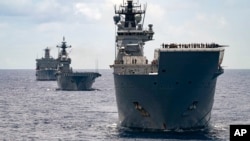Australia Tuesday announced a multibillion overhaul of its navy, which senior officials say is in response to “increasing geostrategic uncertainty.”
Australian Defense Minister Richard Marles told reporters Tuesday that the overhaul would give the navy the largest surface fleet since World War II.
The total cost of the plan over the next 10 years is estimated at $35.25 billion.
The revamp of Australia’s naval fleet intends to more than double the number of warships. Analysts say the reforms will help prepare the military for possible armed conflict in the Indo-Pacific region and a growing unease in Canberra about China’s military and territorial ambitions.
Under the Australian plan, there will be up to 11 new general-purpose frigates and a fleet of drone-like boats that can be operated remotely without sailors on board.
A review last year found Australia’s defense force was no longer “fit for purpose” and that the navy needed a more strategic combination of smaller and larger warships.
Vice Admiral Mark Hammond, the chief of the Australian navy, told reporters in Sydney that the new plan would create, in time, the “most lethal…surface combatant force” the country had seen in generations.
“Against the backdrop of increasing geostrategic uncertainty this is a consequential investment in national security,” he said.
The Canberra government aims to grow Australia’s fleet of warships from 11 to 26 vessels by the late 2040s.
Marcus Hellyer, head of research at Strategic Analysis Australia, a defense and security consultancy, told the Australian Broadcasting Corp. that the new plan should reverse years of neglect in the navy.
“It is really important because - I do not want to get too melodramatic - but we are at risk of not having a navy. The chickens have come home to roost from over a decade of terribly bad decision making between the previous government and the senior leadership of defense. So, between the two of them they have got us into a terrible position.”
Australia is also pushing ahead with plans to acquire nuclear-powered submarines under the AUKUS accord with the United States and Britain.
Analysts say that China’s increasing assertiveness is a key motivation behind the trilateral AUKUS agreement, but China has accused the three countries of a “Cold War mentality,” saying the alliance was embarking on a “path of error and danger.”








